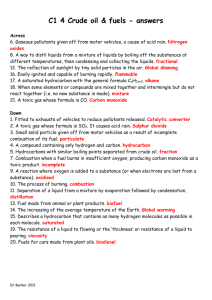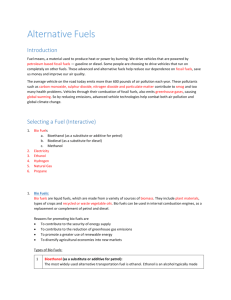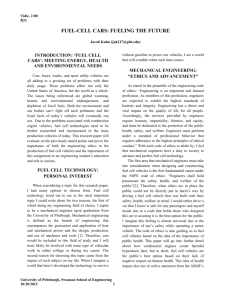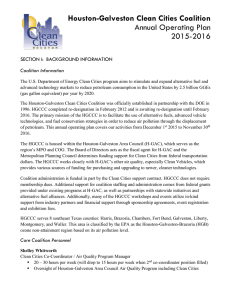6-6_TPC-_Minutes - Silicon Valley Leadership Group
advertisement
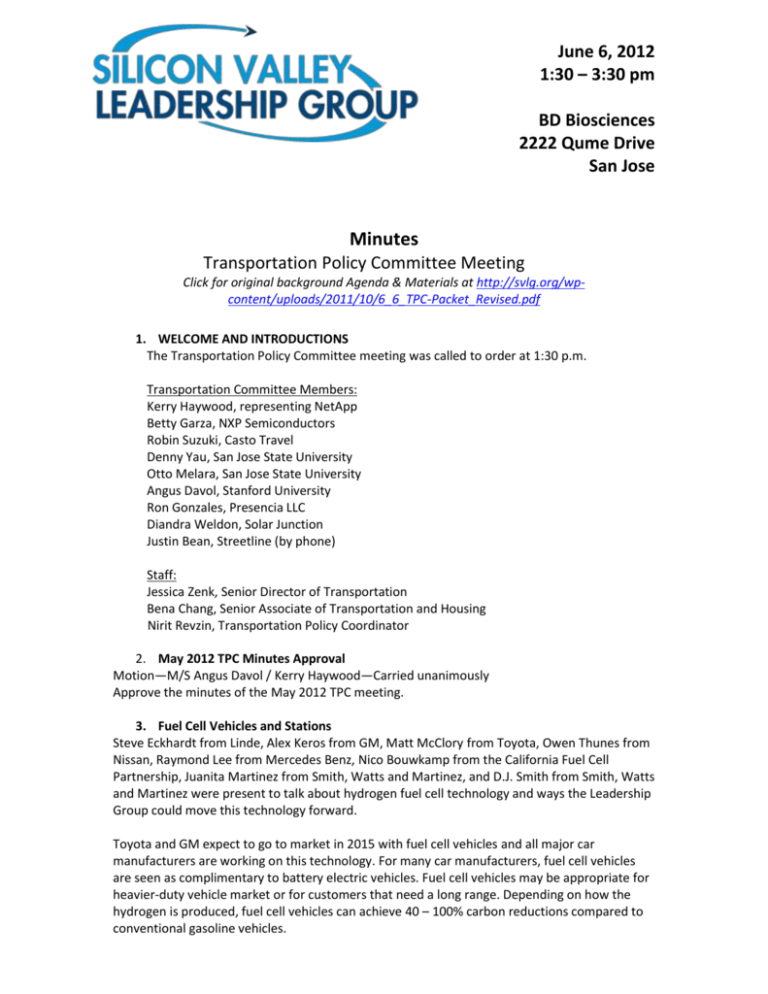
June 6, 2012 1:30 – 3:30 pm BD Biosciences 2222 Qume Drive San Jose Minutes Transportation Policy Committee Meeting Click for original background Agenda & Materials at http://svlg.org/wpcontent/uploads/2011/10/6_6_TPC-Packet_Revised.pdf 1. WELCOME AND INTRODUCTIONS The Transportation Policy Committee meeting was called to order at 1:30 p.m. Transportation Committee Members: Kerry Haywood, representing NetApp Betty Garza, NXP Semiconductors Robin Suzuki, Casto Travel Denny Yau, San Jose State University Otto Melara, San Jose State University Angus Davol, Stanford University Ron Gonzales, Presencia LLC Diandra Weldon, Solar Junction Justin Bean, Streetline (by phone) Staff: Jessica Zenk, Senior Director of Transportation Bena Chang, Senior Associate of Transportation and Housing Nirit Revzin, Transportation Policy Coordinator 2. May 2012 TPC Minutes Approval Motion—M/S Angus Davol / Kerry Haywood—Carried unanimously Approve the minutes of the May 2012 TPC meeting. 3. Fuel Cell Vehicles and Stations Steve Eckhardt from Linde, Alex Keros from GM, Matt McClory from Toyota, Owen Thunes from Nissan, Raymond Lee from Mercedes Benz, Nico Bouwkamp from the California Fuel Cell Partnership, Juanita Martinez from Smith, Watts and Martinez, and D.J. Smith from Smith, Watts and Martinez were present to talk about hydrogen fuel cell technology and ways the Leadership Group could move this technology forward. Toyota and GM expect to go to market in 2015 with fuel cell vehicles and all major car manufacturers are working on this technology. For many car manufacturers, fuel cell vehicles are seen as complimentary to battery electric vehicles. Fuel cell vehicles may be appropriate for heavier-duty vehicle market or for customers that need a long range. Depending on how the hydrogen is produced, fuel cell vehicles can achieve 40 – 100% carbon reductions compared to conventional gasoline vehicles. Currently, in California there are 6 public hydrogen stations available with 2 more to open soon. By the end of 2013, the California Fuel Cell Partnership expects to have 20 public stations in California. The roadmap for future development is to have 46 stations in five urban clusters in California. 22 additional stations will be deployed to connect clusters to each other. Questions: Are you looking to put hydrogen fueling stations where current gas stations are? SE: Yes. Are there safety concerns for neighborhoods around fueling stations? SE: Yes, just like there are for any other fuels. In case of an accident, hydrogen “spills” go up into the air, unlike gasoline. There are detailed codes for hydrogen use. Is there safety testing for the vehicles? What is the website that promotes fuel cells? cafcp.org AK: GM has performed extensive safety testing on the cars and wouldn’t put something on the road that it thought was unsafe. What is the cost of the vehicle? SE: It’s going to be expensive because it is a new technology. The cost might be around $75,000. Have you thought about holding a competition for cities interested in having a station? No, currently the focus has been on educating cities. Some jurisdictions have indicated interest in supporting the technology. Discussion: Silicon Valley should be the center of fuel cell vehicle and infrastructure deployment. The Leadership Group should play a role as a neutral entity that serves as a “buffer” between the industry and stakeholders. Infrastructure deployment for hydrogen is going to face neighborhood opposition and a “trust me” answer won’t go far. We need to have a fact-based position that acknowledges concerns. There was a desire for more information on the technology and how current stations are doing. 4. Partners for Advanced Transportation Technologies (PATH)/ITS Projects Presentation at: http://svlg.org/wp-content/uploads/2011/10/BerkeleyITSPresentation.pdf Lisa Hammon and Leah Anderson from UC Berkeley’s PATH program gave an overview of their ITS research project. UC Berkeley is working on connected corridor technologies with a focus on the 101-280-El Camino Real corridor. Berkeley is looking for subjects for a survey on the kinds of incentives that would motivate commuters to switch route, commute method, and/or time of day for their travel. Information on origin/destinations from employers would be very useful. Questions: What does success look like for this project? LH: Ideally, we would like to optimize the network flow by route and see shifts in traffic from 101 to 280 or El Camino. Are you working with companies like Waze? How is your program different from what Waze provides? LH: Yes, we are working with Waze. LA: The primary difference in the programs is that the PATH program will include aspects of gaming and competition. The goal is to make this fun and interactive. Will this program compare travel times by car versus transit? LH: Yes. PATH already has a program like this. Decision: None. Information item. 5. Transportation Work Plan Due to lack of time, this item was postponed to a future meeting. 6. Announcements Bike to Work Month and Day – early results indicate that Bike to Work Day participation was up 26% in Santa Clara and San Mateo Counties in 2012 as compared to 2011 SPUR SJ upcoming events (http://www.spur.org/sanjose): o Wednesday, 6/27, 6:30pm: A Conversation with The New Yorker’s David Owen o Thursday, 6/28, 6:00pm: Designing Silicon Valley Next Meeting: 7/11, 1:30-3:30 @ BD Biosciences CalStart Workplace Charging Event @ Google, 7/31, 8:30-5: present on leased space? http://calstart.org/events/CALSTART-Events.aspx Save the Date: Charged 2012 @ SAP, August 23-24, 2012 7. Meeting adjourned at 3:35pm.







